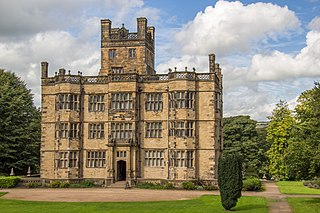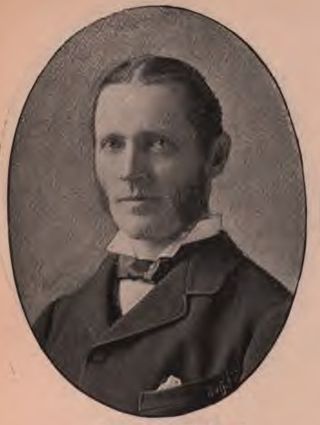
Earl of Derby is a title in the Peerage of England. The title was first adopted by Robert de Ferrers, 1st Earl of Derby, under a creation of 1139. It continued with the Ferrers family until the 6th Earl forfeited his property toward the end of the reign of Henry III and died in 1279. Most of the Ferrers property and the Derby title were then held by the family of Henry III. The title merged in the Crown upon Henry IV's accession to the throne in 1399.

Sir James Phillips Kay-Shuttleworth, 1st Baronet of Gawthorpe Hall, Lancashire, was a British politician and educationist. He founded a further-education college that would eventually become Plymouth Marjon University.

Earl of Lonsdale is a title that has been created twice in British history, firstly in the Peerage of Great Britain in 1784, and then in the Peerage of the United Kingdom in 1807, both times for members of the Lowther family.

Baron Middleton, of Middleton in the County of Warwick, is a title in the Peerage of Great Britain, created in December 1711 for Sir Thomas Willoughby, 2nd Baronet, who had previously represented Nottinghamshire and Newark in Parliament. It was one of twelve new peerages created together and known as Harley's Dozen, to give a Tory majority in the House of Lords.

Baron Stanley of Alderley, in the County of Chester, is a title in the Peerage of the United Kingdom. It was created in 1839 for the politician and landowner Sir John Stanley, 7th Baronet.
Baron Hothfield, of Hothfield in the County of Kent, is a title in the Peerage of the United Kingdom. It was created in 1881 for Sir Henry Tufton, 2nd Baronet, who was appointed Lord Lieutenant of Westmorland the same year and who also served briefly as a government whip in the Liberal administration of 1886. His eldest son, the second Baron, notably served as Mayor of Appleby, Westmorland. On the death of his son, the third Baron, in 1961, this line of the family failed. The late Baron was succeeded by his first cousin, the fourth Baron. He was the only son of the Hon. Sackville Philip Tufton, second son of the first Baron. On his death in 1986 this line of the family also failed and the titles passed to his first cousin, the fifth Baron. He was the eldest son of the Hon. Charles Henry Tufton, third son of the first Baron. As of 2017 the titles are held by his son, the sixth Baron, who succeeded in 1991.

Baron Hesketh, of Hesketh in the County Palatine of Lancaster, is a title in the Peerage of the United Kingdom. It was created in 1935 for Sir Thomas Fermor-Hesketh, 8th Baronet, who had previously briefly represented Enfield in the House of Commons as a Conservative. As of 2010 the titles are held by his grandson, the third Baron, who succeeded his father in 1955. Lord Hesketh held junior ministerial positions in the Conservative administrations of Margaret Thatcher and John Major. However, he lost his seat in the House of Lords after the House of Lords Act 1999 removed the automatic right of hereditary peers to sit in the upper chamber of Parliament.

There have been three baronies created for the Gerard family who lived historically at Bryn, Ashton-in-Makerfield, Lancashire and Kingsley, Cheshire, in the 13th century. The third and current barony was created in 1876.
Baron Congleton, of Congleton in the County Palatine of Chester, is a title in the Peerage of the United Kingdom. It was created in 1841 for the Whig politician, former Secretary at War, and Paymaster of the Forces Sir Henry Parnell, 4th Baronet. His eldest son, the second Baron, devoted his life to religious work and was an early member of the Plymouth Brethren. The latter was succeeded by his younger brother, the third Baron. He served in the Royal Navy and fought at the Battle of Navarino in 1827. His eldest surviving son, the fourth Baron, was a major general in the British Army and served in the Crimean War and the Anglo-Zulu War. The latter's eldest son, the fifth Baron, was killed in action in Ypres Salient during the First World War and was succeeded by his younger brother, the sixth Baron. As of 2015, the titles are held by the latter's grandson, the ninth Baron, who succeeded his father in 2015.
Baron Crawshaw, of Crawshaw in the County Palatine of Lancaster and of Whatton in the County of Leicester is a title in the Peerage of the United Kingdom. It was created on 25 August 1892 for Sir Thomas Brooks, 1st Baronet. He notably served as High Sheriff of Lancashire in 1884. Brooks had already been created a baronet in the Baronetage of the United Kingdom, of Crawshaw Hall and Whatton House, on 9 February 1891. As of 2013 the titles are held by his great-grandson, the fifth Baron, who succeeded his elder brother in 1997.

Baron Clitheroe of Downham in the County of Lancaster is a title in the Peerage of the United Kingdom. It was created in the 1955 Birthday Honours for the Conservative politician Ralph Assheton, who had previously served as Financial Secretary to the Treasury. He was the son of Ralph Cockayne Assheton, for many years a member of the Lancashire County Council, who had been created baronet of Downham in the County of Lancaster, on 4 September 1945. Three months after being raised to the peerage, Lord Clitheroe succeeded his father in the baronetcy. As of 2017, the titles are held by the first Baron's son, the second Baron, who succeeded in 1984.
Baron Cawley, of Prestwich in the County Palatine of Lancaster, is a title in the Peerage of the United Kingdom. It was created in 1918 for the Liberal politician Sir Frederick Cawley, 1st Baronet. He had previously represented Prestwich in the House of Commons and served as Chancellor of the Duchy of Lancaster from 1916 to 1918. Before his elevation to the peerage, Cawley had been created a baronet, of Prestwich in the County Palatine of Lancaster, in the Baronetage of the United Kingdom, in 1906. His grandson, the third Baron, notably served as Deputy Chairman of Committees in the House of Lords from 1958 to 1967. As of 2023 the titles are held by the latter's eldest son, the fourth Baron, who succeeded in 2001.

Gawthorpe Hall is an Elizabethan country house on the banks of the River Calder, in Ightenhill, a civil parish in the Borough of Burnley, Lancashire, England. Its estate extends into Padiham, with the Stockbridge Drive entrance situated there. The house is traditionally attributed to Robert Smythson. In the mid-19th century, the hall was rebuilt by Charles Barry, the architect of the Houses of Parliament. Since 1953 it has been designated a Grade I listed building. In 1970 the 4th Lord Shuttleworth gave the hall to the National Trust, with a 99-year lease to Lancashire County Council. Both bodies jointly administer the hall and in 2015 the council provided £500,000 funding for restoration work on the south and west sides of the house.

Ughtred James Kay-Shuttleworth, 1st Baron Shuttleworth,, known as Sir Ughtred Kay-Shuttleworth, 2nd Baronet between 1872 and 1902, was a British Liberal politician and landowner. He was Under-Secretary of State for India and Chancellor of the Duchy of Lancaster under William Ewart Gladstone in 1886 and Parliamentary and Financial Secretary to the Admiralty under Gladstone and Lord Rosebery between 1892 and 1895.
There have been three baronetcies created for members of the Mosley family, one in the Baronetage of England and two in the Baronetage of Great Britain. Only one creation is extant. Since 1980, the title has been held jointly with Baron Ravensdale in the Peerage of the United Kingdom.

Sir John Marjoribanks, 1st Baronet was a Scottish MP and twice Lord Provost of Edinburgh.

The Hon. Rachel Beatrice Kay-Shuttleworth MBE (1886–1967) was an English embroiderer, lace-maker, textile collector, teacher and philanthropist. Her textile collection is held at Gawthorpe Hall in Burnley, Lancashire, her family home.
Kay-Shuttleworth is a surname, created when James Kay (1804-1877) married Janet Shuttleworth (1817-1872) of Gawthorpe Hall on 24 March 1842 and took her name as part of their marriage settlement, becoming James Kay-Shuttleworth.
Richard Ughtred Paul Kay-Shuttleworth, 2nd Baron Shuttleworth was a British officer of the Royal Air Force, peer, and landowner, and a member of the House of Lords from 1939 until his death eight months later.
Ronald Orlando Lawrence Kay-Shuttleworth, 3rd Baron Shuttleworth was a British Army officer who was briefly a peer, landowner, and a member of the House of Lords from 1941 until his death in the Second World War.










